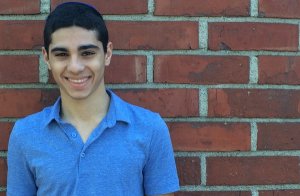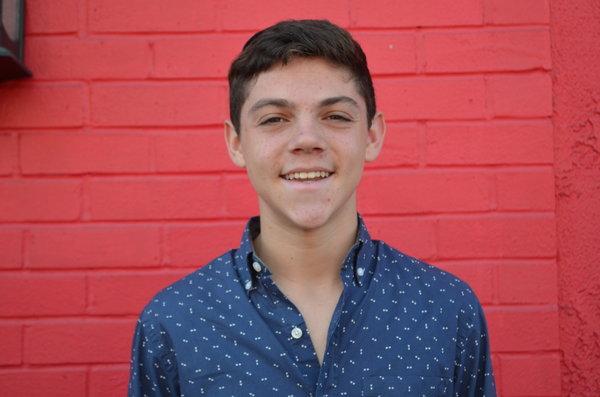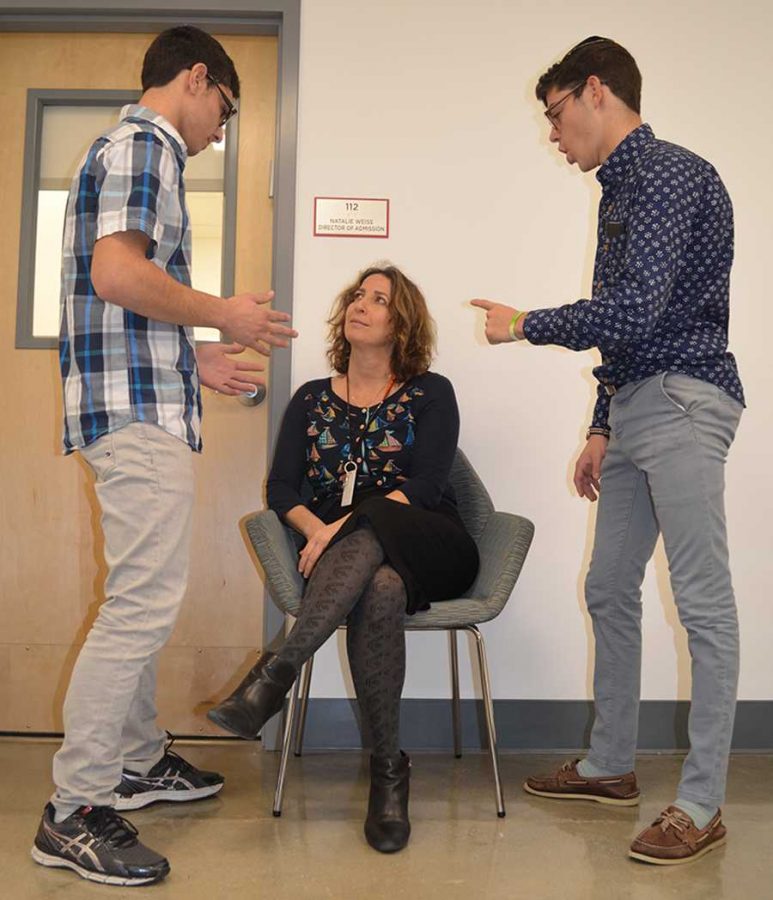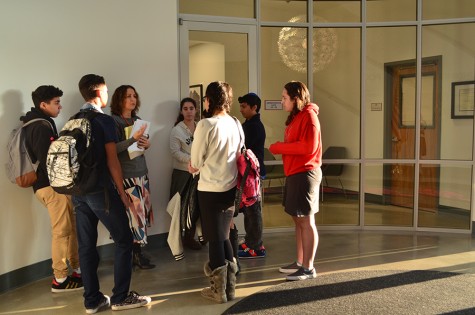TWO BOILING POINTS OF VIEW: Should Shalhevet cap enrollment at 240 students?
February 11, 2016
NO: Keep on growing
By Eric Bazak, Editor-in-Chief 
It’s that time of the year when seniors sweat over interviews and stress over their chances of being accepted to their desired school – and I don’t mean college. I’m actually referring to eighth grade “seniors,” who are busy applying to high school.
Though it wasn’t like this a few years ago, Shalhevet for many reasons has turned into the Ivy League of Jewish high schools. When I interviewed, all I was required to do was schmooze for a few minutes, then leave with a candy bar in hand. Now, the admissions process consists of tours, classroom and Town Hall visits, parlor meetings, mock co-curricular meetings called Winterm and, for whatever it’s worth, parent interviews – in addition to Open House, interviews, test taking and essay writing that we’ve had all along.
That’s because Shalhevet has capped the number of each new freshman class at 60, despite receiving an increasing number of applications every year. Administration says it does this to preserve the small, comfortable atmosphere that has characterized our school.
While that is a totally legitimate rationale, the school and some eighth-graders would gain tremendously if Shalhevet’s doors were more open.
Among other benefits, larger classes enhance our co-curriculars, boosts the school’s finances, and diversify our student body. And of course, every student we turn down is a student not introduced to Lahav – Shalhevet’s pioneering Judaic curriculum – or the Just Community or our great teachers.
Also, it’s in our best interest to be a medium-sized school. Ask any senior who attended college informational meetings: admissions reps of middle-sized colleges always mention that their school has the benefits of large-school resources while still maintaining that liberal arts, cozy vibe. With an expanding student population these past few years, our school has nearly reached that ideal equilibrium of a middle-sized school. But for now, we’re still more “small” tan “medium.”
When I was a freshman, Shalhevet was too small. There weren’t enough people to populate the dozens of clubs students conceived of forming. Even for the clubs we did have, the smaller student population generally meant fewer people who were especially talented or interested, and a small cadre of super-active students were leaders of everything.
We were also more in debt. Fewer people involved in the school meant fewer donors and families supporting our community.
Also, everybody knew everybody. While we were all extremely close, that tightness often felt claustrophobic. We were not supplied with so many choices as to who we wanted as friends, and it’s not always great for the entire school to know so much about you.
Now, look where we are in comparison. Our co-curriculars have never been stronger; one transfer student came in this year and managed to raise $20,000 in funding to start a robotics club. Fashion club, another start-up this year, has drawn the interest of dozens. Firehawks for Israel and Finance Club have both been revamped and are thriving. There are even 30 singers in the Choirhawks.
Financially, Shalhevet has never been in as good of a place, and that can be partially attributed to a larger pool of generous donors supporting Shalhevet and more parents paying tuition.
We also have greater student diversity. Every added student or faculty member contributes another talent, story and perspective to the school. I also have more choices as to which people I spend my time with during and outside school.
Some may lament the fact that they can’t recognize 90-plus percent of the student body by the end of the first semester. But this is not a problem. It merely gives us the opportunity to build relationships with “strangers” in March and April. We’re still a very strong and united community, but now there’s room to breathe.
So what’s the magic number? It’s difficult to say. The building has limitations and we shouldn’t accept students who wouldn’t benefit from what Shalhevet offers.
But with eighth-graders engaging in such cutthroat competition to be accepted, a growing wait-list of admittable students and ample room left in the basement to create more classrooms, 60 is unnecessarily small.
Let’s not be forced to deny an eighth-grader all of his or her potential growth at Shalhevet because his ISEE scores were below average, or because he didn’t show enough interest in the school by coming to enthusiasm-building events like parlor meetings or Winterm — or because his parents had a weak interview.
YES: We need to stay a family
By Micah Gill, 12th Grade 
If you were to walk into any Shalhevet parlor meeting — whether in the past, present, or, for that matter, even future — I can guarantee that you would hear someone say, “What separates Shalhevet is…” or “This is why we’re so different.” And to be frank, I’ve come to believe it. I believe that we are 100 percent unique and the only school of our kind.
I used to be skeptical; I often thought that Shalhevet was nothing more than a run of the mill Modern Orthodox High School. Sure, we’re (very) quirky, and sure, we have a Just Community, but it wasn’t until my junior year that I fully realized and came to appreciate the extent of what makes Shalhevet Shalhevet.
Part of the reason is our size.
When I came to Shalhevet as a freshman in 2012, not only did I fail to notice anything that differentiated our school, but I didn’t think of school as anything more than, well, school. I knew the kids in my grade and a couple sophomores from my middle school, and looked up in awe to my senior buddy and her friends. At that point, even as an outgoing and gregarious kid, there was a large contingent of Shalhevet that I didn’t know existed. Back then, the school was about 160 kids, and to me, it felt like 260.
As junior year rolled around, my position on the Agenda committee had gotten more serious and required more student interaction. I had met many more kids and began to think of Shalhevet as more of a family than a collection of students with whom I spent my time. I had developed bonds with classmates with whom I would’ve never guessed I would connect, and to be honest, I probably knew the names of over 90 percent of the school.
This year, as I walk the halls of our new, much anticipated and glorious building, as I try to appreciate and savor the last months of Shalhevet I have left, it seems as if I see a new freshman every day. “Sorry, what’s your name?” comes out of my mouth much more than I would like and I can’t seem to shake the same thought: what’s happening to my Shalhevet?
The Shalhevet that I know — my Shalhevet, if you will — is a family. It’s a place that stands in stark contradistinction to the “classic” high school. We don’t haze, there isn’t a hierarchy with seniors at the top and freshmen at the bottom, teachers are much more than just teachers, we don’t fear our administrators, and overall, we nurture an environment of warmth. People are nice to each other for the sole purpose of “we both go to Shalhevet — let’s be friends.”
And this is the key: that mentality – the mentality of enjoying our time in school, feeling comfortable in the hallways, remaining happy in the classroom, and looking forward to returning after a long weekend or vacation – can only exist if we keep our grades small. Walking as individuals in a sea of strangers, always looking for my friends and my teachers – that isn’t family. Family is sitting in Town Hall, looking left and looking right, and sensing a feeling of comfort, responsibility and pride for those around us. Quite simply, this phenomenon cannot be achieved if class size proliferates.
It may be possible that 60 kids per grade is the perfect number; I don’t know. Maybe I think it’s big because I’m pitting it against my previous years of smaller sized grades. However, I do know this: Shalhevet is only Shalhevet if I know my classmates.
Our building is fancy, our academics are strong, the Just Community is thriving — all of which is remarkable. However, through the fundraising and through the hiring, through the studying and through the testing, we cannot lose what makes us, us: a sense of family.

